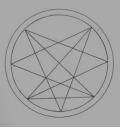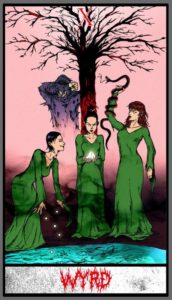Posted: February 13th, 2017 | Author: baeldraca | Filed under: Heretical Texts, O9A, Order of Nine Angles, Order of the Nine Angles, Satanic Heresy, The Sinister Tradition, The Sinisterly Numinous Tradition | Tags: Anarchy, Anton Long, Labyrinthos Mythologicus, Left Hand Path, O9A, O9A Aural Tradition, O9A Mythos, Occultism, Order of Nine Angles, Order of the Nine Angles, Satanism, Seven Fold Way, Traditional Satanism | Comments Off on Anarchy
°°°°°
In its essence, the Order of Nine Angles is, and always has been, anarchic {1}, where a useful, working, definition of anarchy is “that way of living which regards the authority of The State as unnecessary and possibly harmful, and which instead prefers the free and individual choice of mutual and non-hierarchical co-operation”.
This anarchism of ours is evident, for example, in (a) our non-hierarchical, communal, nature and structure; (b) in our disdain for the principles of ‘copyright’ and ‘intellectual property’; (c) in our insistence on internal change and development, where everything ONA “can and should be surpassed, refined, changed, when others discover, experience, and attain knowledge and experience for themselves” {2}; and (d) in our Code of Kindred Honour which places the law of kindred honour over and above the laws of The State.
If there is a ‘secret’ about the O9A, then it is this.
°°°
Notes
{1}. Refer to:
(a) The text The ONA and Anarchy first circulated in 1991 ev, included in some compilations of ONA MSS published in the 1990s.
(b) The letter to Aquino, dated 7th September 1990 ev, in Vol I of The Satanic Letters of Stephen Brown.
{2}. Satanic Letters of Stephen Brown, Letter to Miss Stockton, dated 19th June, 1991 ev
Posted: August 12th, 2016 | Author: baeldraca | Filed under: O9A, Order of Nine Angles, Order of the Nine Angles, Satanic Polemics, The Sinister Tradition, The Sinisterly Numinous Tradition | Tags: Anton Long, Left Hand Path, Modern Satanism, O9A Mythos, Order of Nine Angles, Order of the Nine Angles, Satanism, The Sinister Tradition, Traditional Satanism. O9A Logos | Comments Off on Academia And The Occult

Order Of Nine Angles
In respect of the subject now often denoted by the term Western esotericism, can a lecturer or a faculty member at an established, mainstream, university or college be relied upon to present a well-researched, unbiased, scholarly, article or book?
Consider, for example, a recent (2016) book published by the prestigious Oxford University Press, Children of Lucifer: The Origins of Modern Religious Satanism, written by Ruben Van Luijk. This book devotes several pages (371-373) to the Order of Nine Angles (ONA, O9A) and to Anton Long, making various unsubstantiated claims while in the process getting almost every fact about Myatt wrong. That such an author, published by such an academic press, could make so many unsubstantiated claims and so many mistakes in so few pages – mistakes arising from a lack of research using primary sources – does not inspire confidence in the rest of the book nor in the process of academic peer review.
The mistakes by Van Luijk about Myatt include:
1) That Myatt joined the ‘British National Socialist Movement’ in 1968. Myatt in fact joined Colin Jordan’s British Movement that year, Jordan having disbanded his short lived ‘National Socialist Movement’ earlier in the year.
2) Van Luijk writes that Myatt’s pamphlet A Practical Guide To Aryan Revolution “included detailed instructions for the manufacture of explosives and the incitement of racial war.”
It seems that Van Luijk has not bothered to find and read that pamphlet, for while it does “incite racial war” (in the Racial War section) it does not contain detailed instructions about making bombs, with it being apparent that Van Luijk has confused that pamphlet with another similar one also attributed to Myatt {1}, the 15-page printed document circulated in the 1990s which announced the formation of The White Wolves and which document did indeed contain instructions on how to make home-made bombs, complete with diagrams.
That the pamphlet A Practical Guide To Aryan Revolution – attributed to Myatt – has never in its entirely been republished (on the internet or otherwise) and is not available in easily accessible academic libraries, surely makes it incumbent upon accredited scholars who wish to comment upon it to seek out and read it in its entirely in such few places as it can still be found.
3) Van Luijk repeats the claim made by certain other authors that Myatt is Anton Long without (i) providing any evidence from his own research using primary sources that Myatt is indeed Anton Long, and without (ii) referencing any academic sources which, on the basis of scholarly research using primary sources, have proven that Myatt is Long. {2} Furthermore, that there are no such academic sources which, on the basis of scholarly research using primary sources, have proven that Myatt is Long, is never mentioned by Van Luijk.
4) Van Luijk writes that Myatt was “initiated in 1968 by the female leader of a Wicca coven.” Nowhere, in the writings of Anton Long, is there any claim to have been initiated either in 1968 or by someone from a wicca coven. Rather, the claim made by the pseudonymous Anton Long is of being initiated in the early 1970s and by the daughter of a lady associated with a pagan, occult, tradition.
The unsubstantiated claims of Van Luijks about the O9A include:
1) That the name ‘Order of Nine Angles’ suggests inspiration from the ‘satanism’ of Howard Stanton Levey and his Church of Satan, whereas a reading of (i) basic O9A texts such a The Order of Nine Angles Rite of The Nine Angles: A Comparison with the Ceremony of Nine Angles by Aquino And A Brief Study of The Meaning of The Nine Angles, and (ii) of Professor Monette’s conclusion that “it is clear despite claims that the term ‘nine angles’ was introduced in the twentieth century, the term is centuries older, especially in esoteric or cosmological discourse,” {3} would have revealed there was no such inspiration.
Myatt himself even makes a comparison with the ancient Somnium Scipionis described by Cicero, in De Re Publica, Book VI, 17, which mention of ‘nine’ pre-dates Levey and his Church of Satan by over a thousand years.
2) That the O9A accept the Judaeo-Christian version of Satan, whereas a reading of basic O9A texts such as The Geryne of Satan would have revealed that the O9A do not accept that version of Satan, giving rise to the O9A understanding of a satanist as a person who – ‘diabolically’ or otherwise – is opposed to those who believe themselves to be God’s chosen people; that is, someone opposed to the Jews.
3) That the O9A is just a development of the ‘satanism’ of Howard Stanton Levey, whereas a study of the O9A corpus, from the 1980s on, and O9A works such as the compilation The Esoteric Hermeticism Of The Order Of Nine Angles, would have revealed that the O9A represent an occult, essentially pagan, tradition wholly different from the qabalistic-centred occult tradition used by Crowley, Levey, Aquino, and other modern occultists. A difference evident in the O9A’s Seven Fold Way and their occult septenary system.
4) That the O9A Star Game is just a ‘board game’, whereas a reading of basic O9A texts such as Naos would have revealed its three-dimensional and unique nature, a uniqueness derived from the transformation of each piece when it is moved and the alchemical combinations and occult associations of each piece.
The lack of detailed, scholarly, research and the mistakes made by Van Luijk are unfortunately typical of many of the books and articles written by academics about modern Satanism in particular and the Western, occult, Left Hand Path in general, with many authors of recent works relying for instance on the opinions of others (and, sometimes, even relying on anonymous persons communicated with by means of e-mail) rather than undertaking their own years-long research using primary sources.
Thus, in respect of Western esotericism, can a lecturer or a faculty member at an established, mainstream, university or college be relied upon to present a well-researched, unbiased, scholarly, article or book? The answer, more often than not, is no, for so many such books and articles are written by those who, despite being accorded the status of academics, are not scholars because their approach to the subject they write about it is quite unscholarly. {2}
R. Parker
2016
This a revised version of an article previously circulated under the title More Unscholarly Research.
Notes
{1} Searchlight, July 2000.
{2} Correctly understood, a scholarly approach means undertaking a meticulous, unbiased, research into a specific subject over a period of some years using, wherever possible, primary sources; formulating an opinion based on such learning, such knowledge, as results from such research, and in respect of writing academic papers and books about the subject providing copious, accurate, references to the source material. Primary sources include direct evidence such as original documents dating from the period under study, and accounts and works (written, verbal, published or unpublished) by such individuals whose life or whose writings or whose works form part of the research. In addition, if such sources – documents or accounts or writings – are in another language, then it is incumbent upon the scholar to have knowledge of that language and thus be able to translate such documents themselves, for a reliance upon the translations of others relegates such sources from the position of primary ones to secondary ones.
Hence, if the author of an academic book or academic paper writes about a person and/or about their works, or about an event, using only secondary sources – sources containing the opinions, the interpretations, or the conclusions of others – then the opinion, the interpretation, the conclusions of that author about such a person and/or about their works, or about an event, are unauthoritative because unscholarly.
{3} Monette, Connell (2013). Mysticism in the 21st Century. Sirius Academic Press. p.105.

